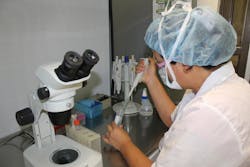A new technique developed by Jun Hee Lee, PhD, and his team at the University of Michigan Medical School uses high-throughput sequencing, instead of a microscope, to obtain ultra-high-resolution images of gene expression from a tissue slide, according to a news release from Michigan Medicine.
The technology, which they call Seq-Scope, enables a researcher to see every gene expressed, as well single cells and structures within those cells, at incredibly high resolution: 0.6 micrometers or 66 times smaller than a human hair — beating current methods by multiple orders of magnitude.
Lee, Associate Professor in the Department of Molecular & Integrative Physiology, said, “With our new method, we have made a microdevice that you can overlay with a tissue sample and sequence everything within it with a barcode with spatial coordinates.”
Each so-called barcode is made up of a nucleotide sequence—the pattern of A, T, G, an C—found in DNA. Using these barcodes, a computer is able to locate every gene within a tissue sample, creating a Google-like database of all of the mRNAs transcribed from the genome.
This knowledge could be used to provide insight into why certain patients respond to certain drugs while others do not, said Lee.
The team demonstrated the effectiveness of the technique using normal and diseased liver cells, successfully identifying dying liver cells, their surrounding inflamed immune cells and liver cells with altered gene expression.
“This technology actually showed many known pathological features that people have previously discovered, but also many genes that are regulated in a novel way that was unrecognized previously,” said Lee. “Seq-Scope technology, combined with other single cell RNA sequencing techniques, could accelerate scientific discoveries and might lead to a new paradigm in molecular diagnosis.”
The work is described in the journal Cell.

